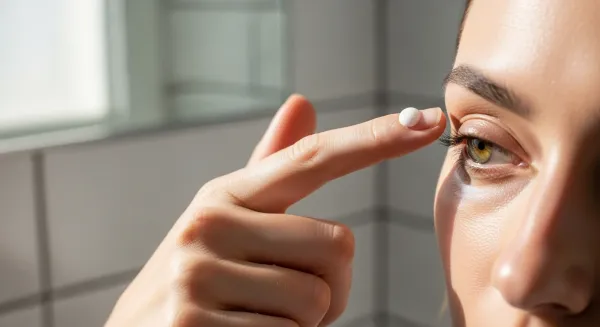The Ultimate Guide to Choosing Sunscreen for Acne-Prone Skin
Learn how to choose the best sunscreen for acne-prone skin with tips on ingredients, application, and daily care.

Choosing the right sunscreen is crucial, especially for those with acne-prone skin.
Sunscreen not only protects against harmful UV rays but also helps prevent breakouts and skin irritation.
In this guide, we'll explore how to select the best sunscreen to keep your skin clear and healthy while enjoying the sun.
Key Takeaways
- Always choose a non-comedogenic sunscreen to avoid clogged pores.
- Look for oil-free formulas that feel light on the skin.
- Apply sunscreen daily, even on cloudy days, to protect your skin.
- Reapply every two hours, especially if you're sweating or swimming.
- Consider mineral sunscreens with zinc oxide for sensitive and acne-prone skin.
Understanding Sunscreen for Acne-Prone Skin

Why Sunscreen is Essential
We all know that sunscreen is a must for everyone, especially for those of us with acne-prone skin.
It protects us from harmful UV rays that can cause damage and irritation. Without it, our skin can become red and inflamed, which is the last thing we want!
How Sunscreen Works
Sunscreen acts like a shield for our skin. It absorbs or reflects UV rays, preventing them from penetrating our skin.
This is super important because UV rays can worsen hyperpigmentation from old acne scars. So, using a broad-spectrum sunscreen with SPF 30 or higher daily is key to keeping our skin healthy.
Common Myths About Sunscreen
There are a lot of myths floating around about sunscreen. Here are a few we should clear up:
- Myth 1: "I don’t need sunscreen on cloudy days."
Truth: Up to 80% of UV rays can penetrate clouds, so we should apply sunscreen every day. - Myth 2: "Sunscreen makes me break out."
Truth: Choosing the right, non-comedogenic sunscreen can actually help prevent breakouts. - Myth 3: "I only need to apply sunscreen once a day."
Truth: We need to reapply every two hours, especially if we’re sweating or swimming.
Remember, protecting our skin from sun damage is key to keeping it healthy and clear!
Choosing the Right Sunscreen for Acne-Prone Skin

When it comes to picking a sunscreen for our acne-prone skin, we need to be super careful about what we choose.
Not all sunscreens are created equal!
Here’s what we should keep in mind:
Ingredients to Look For
- Non-comedogenic: This means it won’t clog our pores.
- Oil-free: Helps keep our skin from getting greasy.
- Zinc oxide: A great ingredient that protects our skin without causing breakouts.
Ingredients to Avoid
- Fragrances: These can irritate our skin.
- Alcohol: Can dry out our skin and lead to more oil production.
- Heavy oils: Like coconut oil, which can cause breakouts.
Top Recommended Sunscreens
Here’s a quick table of some of the best sunscreens for us:
Product Name | Type | SPF | Key Benefits |
|---|---|---|---|
EltaMD UV Clear | Mineral | 46 | Lightweight, non-comedogenic |
Neutrogena Hydro Boost | Gel | 30 | Hydrating, oil-free |
La Roche-Posay Anthelios | Chemical | 60 | Broad-spectrum, oil-free |
Remember, finding the right sunscreen is key to keeping our skin clear and protected! Let’s make sure we choose wisely to avoid those pesky breakouts while enjoying the sun!
How to Apply Sunscreen Properly
Steps for Effective Application
Applying sunscreen correctly is super important for keeping our skin safe.
Here’s how we can do it:
- Apply at least 15-30 minutes before heading outside. This gives the sunscreen time to absorb into our skin and work its magic.
- Use about a shot glass full for our whole body. Don’t skimp on the amount!
- Make sure to cover all areas, including our ears, neck, and the tops of our feet.
How Much Sunscreen to Use
Here’s a quick guide on how much sunscreen we should use:
Body Part | Amount Needed |
|---|---|
Face and Neck | 1/2 teaspoon |
Arms | 1 teaspoon each |
Legs | 2 teaspoons each |
Full Body | About 1 ounce (shot glass) |
Reapplication Tips
We need to reapply sunscreen every two hours, especially if we’re sweating or swimming. Here are some tips to remember:
- Reapply after swimming or sweating.
- Don’t forget to apply even on cloudy days, as UV rays can still reach us.
- Keep a travel-sized sunscreen handy for easy reapplication on the go!
Remember, applying sunscreen is one of the best things we can do for our skin health. Let’s make it a daily habit!
Daily Sun Protection Tips for Acne-Prone Skin

Incorporating Sunscreen into Your Routine
We all know that sunscreen is a must for everyone, especially for those of us with acne-prone skin. Here’s how we can make it a part of our daily routine:
- Apply sunscreen every day, even when it’s cloudy. Those sneaky UV rays can still cause damage!
- Choose a broad-spectrum sunscreen with at least SPF 30. This helps protect against both UVA and UVB rays.
- Don’t forget to cover all exposed areas, including our ears and neck.
Complementary Sun Protection Methods
Besides sunscreen, we can also protect our skin by:
- Wearing hats and sunglasses to shield our face.
- Seeking shade during peak sun hours (10 AM to 4 PM).
- Using clothing that covers as much skin as possible.
Seasonal Sun Protection Advice
As the seasons change, so should our sun protection strategies:
- Summer: Reapply sunscreen every two hours, especially if we’re sweating or swimming.
- Winter: UV rays can still harm our skin, so keep applying sunscreen even in the cold.
- Spring/Fall: Don’t let cloudy days fool you; UV rays can penetrate through clouds.
Remember, protecting our skin from sun damage is key to keeping it healthy and clear!
Managing Breakouts While Using Sunscreen
Spot Treatment Options
When we’re dealing with those annoying breakouts, spot treatments can be our best friends!
Here are some options we can consider:
- Benzoyl Peroxide: This helps kill bacteria and reduce inflammation.
- Salicylic Acid: Great for unclogging pores and keeping skin clear.
- Tea Tree Oil: A natural alternative that can be effective for some.
Preventing Future Breakouts
To keep our skin looking fresh, we need to be proactive. Here are some tips to help us avoid those unwanted breakouts:
- Keep your face clean: Washing twice daily is key, especially after sweating. The American Academy of Dermatology suggests this.
- Avoid touching your face: Our hands can transfer dirt and oils, leading to more breakouts.
- Moisturize: Even if we have oily skin, a good moisturizer can help balance things out.
When to Consult a Dermatologist
If we’re dealing with severe acne that just won’t budge, it might be time to consult a pro. Here’s when to consider it:
- If over-the-counter treatments aren’t working after a few weeks.
- If we’re experiencing pain or discomfort from our acne.
- If we notice scarring or dark spots developing.
Taking care of our skin is a lifelong journey. Starting with sun protection can help us avoid serious issues down the road.
By following these tips, we can enjoy the outdoors while keeping our skin healthy and glowing!
Additional Skincare Tips for Acne-Prone Skin

Hydration and Moisturizing
Staying hydrated is super important for our skin!
Using a good moisturizer can help keep our skin balanced.
Here are some tips:
- Choose oil-free moisturizers to avoid clogging pores.
- Look for ingredients like hyaluronic acid and glycerin that attract moisture.
- Don’t skip moisturizing even if your skin feels oily!
Diet and Lifestyle Tips
What we eat can really affect our skin. Here are some healthy habits to consider:
- Eat plenty of fresh fruits and veggies.
- Incorporate foods rich in omega-3, like fish, to help reduce inflammation.
- Stay away from processed snacks and sugary drinks.
Stress Management
Stress can trigger breakouts, so managing it is key! Here are some ways to keep stress in check:
- Practice mindfulness or meditation.
- Get regular exercise to boost your mood.
- Make sure to get enough sleep each night.
Remember, taking care of our skin is a lifelong journey. Starting with sun protection can help us avoid serious issues down the road!
Understanding Different Types of Sunscreens
When it comes to sunscreen, we’ve got two main types to consider: mineral and chemical.
Each has its own perks, and knowing the difference can help us make the best choice for our skin, especially if we’re dealing with acne.
Let’s break it down!
Physical vs. Chemical Sunscreens
- Mineral Sunscreens (also called physical sunscreens):
- Chemical Sunscreens:
Quick Comparison Table
Type of Sunscreen | Key Ingredients | How It Works | Best For |
|---|---|---|---|
Mineral | Zinc oxide, titanium dioxide | Reflects UV rays | Sensitive skin |
Chemical | Avobenzone, oxybenzone | Absorbs UV rays | Normal to oily skin |
Choosing the Right One
- If you have sensitive or acne-prone skin, mineral sunscreens are usually the way to go.
- For oily skin, you might prefer a lightweight chemical sunscreen that absorbs quickly.
- Always look for non-comedogenic options to avoid clogging pores.
Remember, the best sunscreen is the one you’ll actually use! Let’s find what works for us and keep our skin protected!
Wrapping It Up: Your Sunscreen Journey
Choosing the right sunscreen for acne-prone skin doesn’t have to be a headache!
Remember to look for oil-free and non-comedogenic options to keep your skin happy. Daily application is key, even on cloudy days, so make it a habit.
Don’t forget to reapply every two hours, especially if you’re out and about. With the right sunscreen, you can enjoy the sun while keeping your skin protected and clear.
So, grab that sunscreen and step out with confidence!






